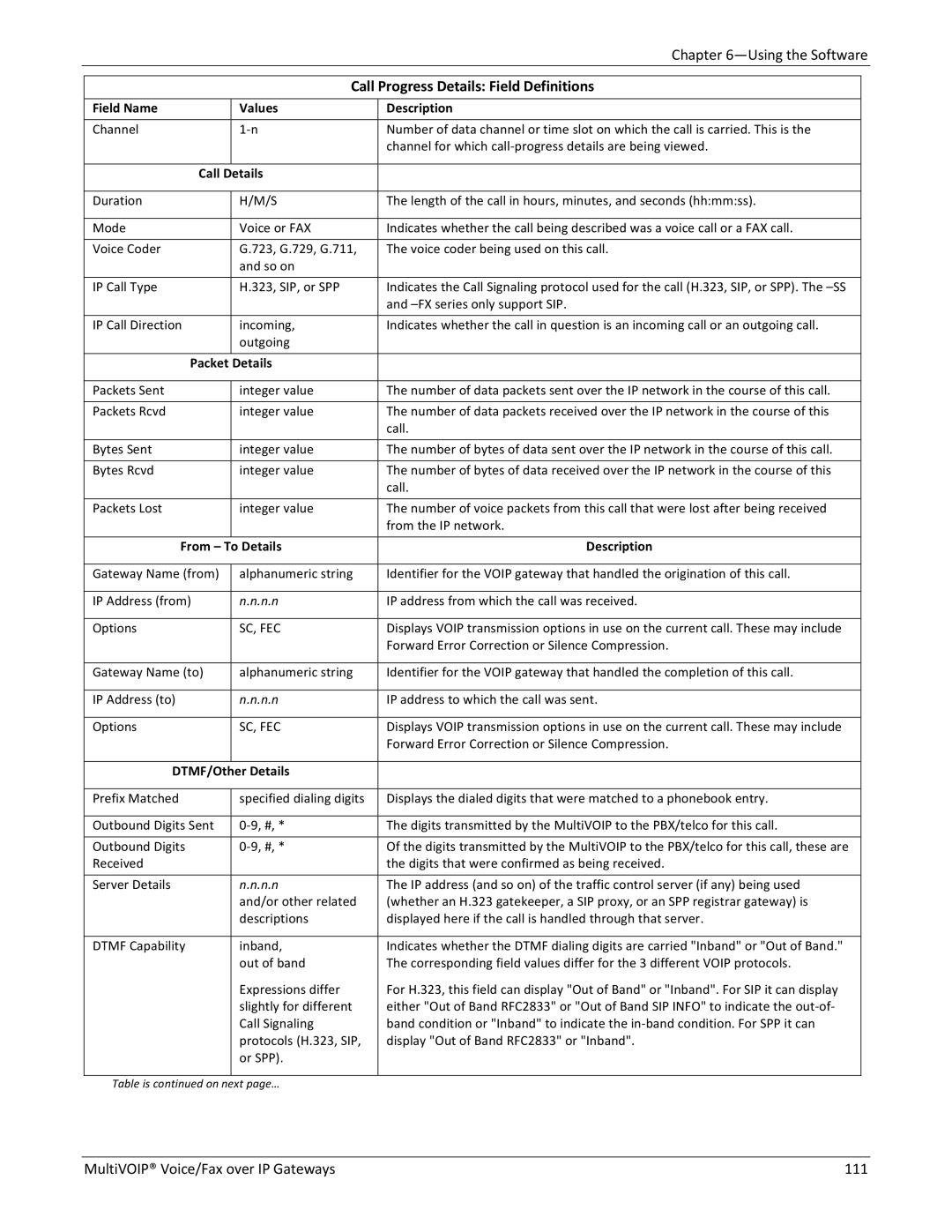
Chapter
Call Progress Details: Field Definitions
Field Name | Values |
|
|
Channel | 1‐n |
|
|
Call Details | |
|
|
Duration | H/M/S |
|
|
Mode | Voice or FAX |
|
|
Voice Coder | G.723, G.729, G.711, |
| and so on |
|
|
IP Call Type | H.323, SIP, or SPP |
|
|
IP Call Direction | incoming, |
| outgoing |
|
|
Packet Details | |
|
|
Packets Sent | integer value |
|
|
Packets Rcvd | integer value |
|
|
Bytes Sent | integer value |
|
|
Bytes Rcvd | integer value |
|
|
Packets Lost | integer value |
|
|
From – To Details | |
|
|
Gateway Name (from) | alphanumeric string |
|
|
IP Address (from) | n.n.n.n |
|
|
Options | SC, FEC |
|
|
Gateway Name (to) | alphanumeric string |
|
|
IP Address (to) | n.n.n.n |
|
|
Options | SC, FEC |
|
|
DTMF/Other Details | |
|
|
Prefix Matched | specified dialing digits |
|
|
Outbound Digits Sent | 0‐9, #, * |
|
|
Outbound Digits | 0‐9, #, * |
Received |
|
|
|
Server Details | n.n.n.n |
| and/or other related |
| descriptions |
|
|
DTMF Capability | inband, |
| out of band |
| Expressions differ |
| slightly for different |
| Call Signaling |
| protocols (H.323, SIP, |
| or SPP). |
|
|
Table is continued on next page…
Description
Number of data channel or time slot on which the call is carried. This is the channel for which call‐progress details are being viewed.
The length of the call in hours, minutes, and seconds (hh:mm:ss).
Indicates whether the call being described was a voice call or a FAX call.
The voice coder being used on this call.
Indicates the Call Signaling protocol used for the call (H.323, SIP, or SPP). The
Indicates whether the call in question is an incoming call or an outgoing call.
The number of data packets sent over the IP network in the course of this call.
The number of data packets received over the IP network in the course of this call.
The number of bytes of data sent over the IP network in the course of this call.
The number of bytes of data received over the IP network in the course of this call.
The number of voice packets from this call that were lost after being received from the IP network.
Description
Identifier for the VOIP gateway that handled the origination of this call.
IP address from which the call was received.
Displays VOIP transmission options in use on the current call. These may include Forward Error Correction or Silence Compression.
Identifier for the VOIP gateway that handled the completion of this call.
IP address to which the call was sent.
Displays VOIP transmission options in use on the current call. These may include Forward Error Correction or Silence Compression.
Displays the dialed digits that were matched to a phonebook entry.
The digits transmitted by the MultiVOIP to the PBX/telco for this call.
Of the digits transmitted by the MultiVOIP to the PBX/telco for this call, these are the digits that were confirmed as being received.
The IP address (and so on) of the traffic control server (if any) being used (whether an H.323 gatekeeper, a SIP proxy, or an SPP registrar gateway) is displayed here if the call is handled through that server.
Indicates whether the DTMF dialing digits are carried "Inband" or "Out of Band." The corresponding field values differ for the 3 different VOIP protocols.
For H.323, this field can display "Out of Band" or "Inband". For SIP it can display either "Out of Band RFC2833" or "Out of Band SIP INFO" to indicate the out‐of‐ band condition or "Inband" to indicate the in‐band condition. For SPP it can display "Out of Band RFC2833" or "Inband".
MultiVOIP® Voice/Fax over IP Gateways | 111 |
